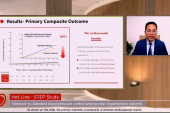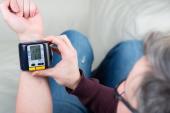Frail Patients Also Benefit From Intensive BP Lowering: SPRINT Analysis
Regardless of frailty status, high-quality BP measurement is key in helping to guide treatment, one expert says.

Patients with frailty derive the same benefits from intensive blood-pressure lowering as those who are not frail, suggests a post hoc analysis of the SPRINT trial.
Frailty didn’t significantly influence the advantages of treating to a systolic BP target below 120 mm Hg versus below 140 mm Hg across a variety of outcomes, or increase the likelihood of serious adverse events, researchers led by Zhiyan Wang, MD (Anzhen Hospital, Beijing, China), report in a study published recently online in Circulation.
“Patients with frailty need special care because they are more likely to experience cardiovascular events,” they say, adding, however, that “intensive antihypertensive therapy can be applied to patients with frailty without unnecessary concerns over harms.”
Physicians tend to be more careful when treating patients they consider frail, although there are few studies that have specifically addressed the use of intensive BP control in this subset, Wang et al note. “With changing demographics, addressing strategies of BP management in the frail population is becoming more important than ever,” they argue. The results of the ongoing RETREAT-FRAIL trial, which is evaluating a reduction in antihypertensive treatment in frail patients over age 80 who have low BP, “are eagerly anticipated.”
Frailty in SPRINT
Wang et al point out that there is some evidence indicating that frail patients do better when their BP remains higher, although that could be related to reverse causation—ie, stemming from a decline in blood pressure toward the end of life.
To find out whether the effects of more-intensive management of BP differ based on frailty status, they turned to the SPRINT trial, which showed—among 9,361 patients with hypertension and high cardiovascular risk—that aiming for the lower systolic BP goal reduced CV events by a relative 25%.
The current analysis included 9,306 participants (mean age 67.9 years; 33.5% women) who had enough information available to calculate a frailty index previously developed by the SPRINT researchers. Based on this, 26.7% of participants were considered frail.
Through a median follow-up of 3.22 years, frail versus nonfrail patients had a greater risk of the primary composite outcome (MI, ACS without MI, stroke, acute decompensated heart failure, and CV death), both in the intensive-treatment arm (adjusted HR 2.10; 95% CI 1.59-2.77) and the standard-treatment arm (adjusted HR 1.85; 95% CI 1.46-2.35).
But the beneficial impact of intensive BP lowering did not differ based on frailty status in terms of the primary outcome (P = 0.35 for interaction) or most secondary outcomes. The lone exception was related to CV mortality, which was not significantly reduced in frail patients (HR 0.91; 95% CI 0.52-1.60) but was in those without frailty (HR 0.30; 95% CI 0.16-0.59; P = 0.01 for interaction).
Frailty also didn’t significantly influence the risk of overall serious adverse events with intensive treatment (P = 0.98 for interaction). Although aiming for the lower BP goal increased risks of hypotension, acute kidney injury, electrolyte imbalance, low sodium, and low potassium in the trial, those effects did not differ based on frailty status.
Importance of Good Measurements
Commenting for TCTMD, Adam Bress, PharmD (University of Utah, Salt Lake City), said the findings of this analysis are consistent with some prior studies, including one from his own group that demonstrated the benefits of intensive BP lowering across levels of baseline CVD risk, which tracks with frailty.
Regarding frail and nonfrail patients, “I would say there’s no evidence that they’re different” when it comes to the impact of intensive treatment, Bress said.
And that’s an important finding for patient care, he said. “For people who are frail, there’s concern or caution amongst clinicians to not lower the blood pressure too much, and understandably so. You don’t want to bottom people out. And these data show that they still get a big cardiovascular disease benefit if you get people in the Goldilocks zone, the just-right blood pressure level, which the data in 2023 indicate is in that 120-130 mm Hg range for most people, including frail people.”
Patients with frailty can be treated the same way as others, Bress said. “I think adhering to best practices and using the guideline-recommended classes and in the correct order . . . is fine. There’s nothing special.”
For all patients, however, high-quality BP measurement, including out-of-office readings, is critical to get the best outcomes, Bress stressed, suggesting that some of the bad experiences physicians may have had in treating frail patients for hypertension could have been related to how they responded to erroneously high readings in the clinic.
Todd Neale is the Associate News Editor for TCTMD and a Senior Medical Journalist. He got his start in journalism at …
Read Full BioSources
Wang Z, Du X, Hua C, et al. The effect of frailty on the efficacy and safety of intensive blood pressure control: a post hoc analysis of the SPRINT trial. Circulation. 2023;Epub ahead of print.
Disclosures
- The study was supported by the National Key Research and Development Program of China, Capital Funds for Health Improvement and Research, and the Beijing Municipal Science and Technology Commission.
- Wang reports no relevant conflicts of interest.





Comments